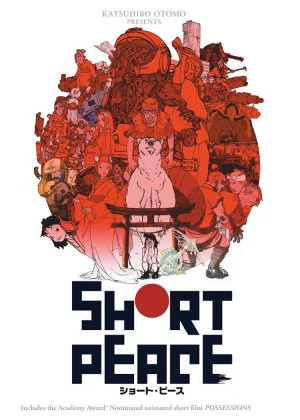Short Peace
Movie details

In a time when full-length anime features are pretty much comatose and their American counterparts are still way too hung up on CG animals and their not-so-funny adventures, a project like Short Peace [Shoto Pisu] is an absolute breath of fresh air. In the fine tradition of anime anthologies, some of the brightest and most talented artists and directors were brought together to muster up a glimpse of the e. The result is absolutely mind-blowing, but to those in the know this shouldn't come as a big surprise.
![screen capture of Short Peace [Shoto Pisu]](/thumbs/img/articles/1200xauto/short-peace-1.webp)
The anthology looks like is a typical Studio 4°C project, except that it isn't. The setup, the reach, the art styles, the directors involved, the freedom ... everything points to Studio 4°C's signature style (think Digital Juice, Memories, Genius Party and Genius Party Beyond). But the production of the shorts was handled by Sunrise and Shochiku, with no mention of Studio 4°C anywhere. It's a little baffling to be honest, but since it doesn't reflect on the final result you won't hear me complaining.
The Short Peace project spans more than just the anthology. The central theme of the project is "Japan across the ages" and with modern time not represented by any of the anthology shorts, they decided to plug that hole by introducing a video game (produced by Crispy's Inc. and Grasshopper Manufacture). As always, the central theme is nothing more than a loose connection between the different shorts, so don't expect too much in the way of an overarching atmosphere. This review only reflects my view on the anthology part of the project, I haven't played the game yet and ranking a cross-media project like this would only make things needlessly complex.
Even though the introduction isn't listed separately as part of the line-up, the fact that it was directed by Koji Morimoto and so clearly carries his mark warrants a special mention. In his typical style, a girl follows a rabbit through a warp hole and traverses several surreal universes. The imagination, the colorful, futuristic designs and the techno/IDM-like soundtrack make this a true Morimoto classic. I still hope he gets around to making a feature film in the same vein, but until that happens I'll take everything I can get. It's just a bit too short for a full mark, but as an opener it hits all the right notes. 4.5*/5.0*
![screen capture of Short Peace [Shoto Pisu]](/thumbs/img/articles/1200xauto/short-peace-2.webp)
The first true short is Shuhei Morita's Tsukumo [Possessions]. Think Kosetsu Hyaku Monogatari meets Mushishi, rendered in Morita's typical style. It closely resembles Morita's Freedom, sans Otomo's influence. The story follows a lone tailor who spends the night in a desolate shrine. Before long ghosts start to hassle the tailor, but rather than freak out he confronts them in his own unique way. The CG is a big step up from Freedom and the story is interesting enough, but it lacks and stand-out features when compared to the other shorts. Still, not bad at all. 4.0*/5.0*
Up next is Katsuhiro Otomo's Hi no Yojin [Combustible]. If you had to link Otomo's name to one of the fives shorts, without any prior knowledge of the anthology, I'm pretty sure Hi no Yojin would come up as the least likely candidate. It looks like nothing Otomo has ever done before (in fact, in looks like nothing anyone in the animation business has ever done before), but then again, those who remember Cannon Fodder may not be all that surprised. The short is set up like a traditional Japanese scroll painting, drawn up in weird diagonals and soft, fuzzy colors. While it starts off quite subdued, the ending is extremely intense and overwhelmingly impressive. Another future Otomo classic. 4.5*/5.0*
![screen capture of Short Peace [Shoto Pisu]](/thumbs/img/articles/1200xauto/short-peace-3.webp)
The third short is Hiroaki Ando's Gambo and it's by far the most gruesome of the bunch. It's bloody, mean and nasty, but never gratuitous or excessive. The short tells of a white bear battling a giant red demon who threatens the safety of the royal family. It's pretty disturbing and violent, but then again so are most non-Disneyfied legends. The art style is a little cruder compared to the rest of the shorts, but the level of detail is remarkably high and the animation is nothing short of stunning. It's a great short that aptly showcases Ando's talents. 4.5*/5.0*
But the best is saved for last. Buki yo Saraba [A Farewell to Weapons] is the film that bares the biggest resemblance to oldskool Otomo, though it's directed by Hajime Katoki (famed mecha designer). If you wonder where the resemblance with Otomo's work comes from, the short is an adaptation of an Otomo manga that goes by the same name. It starts of rather disappointingly, with a plain-looking frame sporting 80s blues and yellows (as if you're watching the opening of the original Hokuto no Ken movie), but once the city, the mechs and the characters are introduced my jaw was glued to the floor. The animation is rich, detailed and quite simply unmatched. The camera work and editing are stupendous and the climax is one of the most thrilling pieces of animation ever put to film. 4.75*/5.0*
Short Peace proudly honors the rich tradition of Japan's animated anthologies. It's up there with the very best, bustling with innovation and creative freedom. There's no weak link here, no bad parts or boring bits. It's a celebration of animation as an art form and it stands in stark contrast to other contemporary feature-length animation films. Watching the umpteenth anime series turned feature film or childish animal-ridden comedy will only get more and more irritating after having watched a film like this. Kudos to Otomo, Morimoto, Ando, Morita and Katoki for making this mind-blowing film. For those with only the slightest interest in animation, this is a must-see.